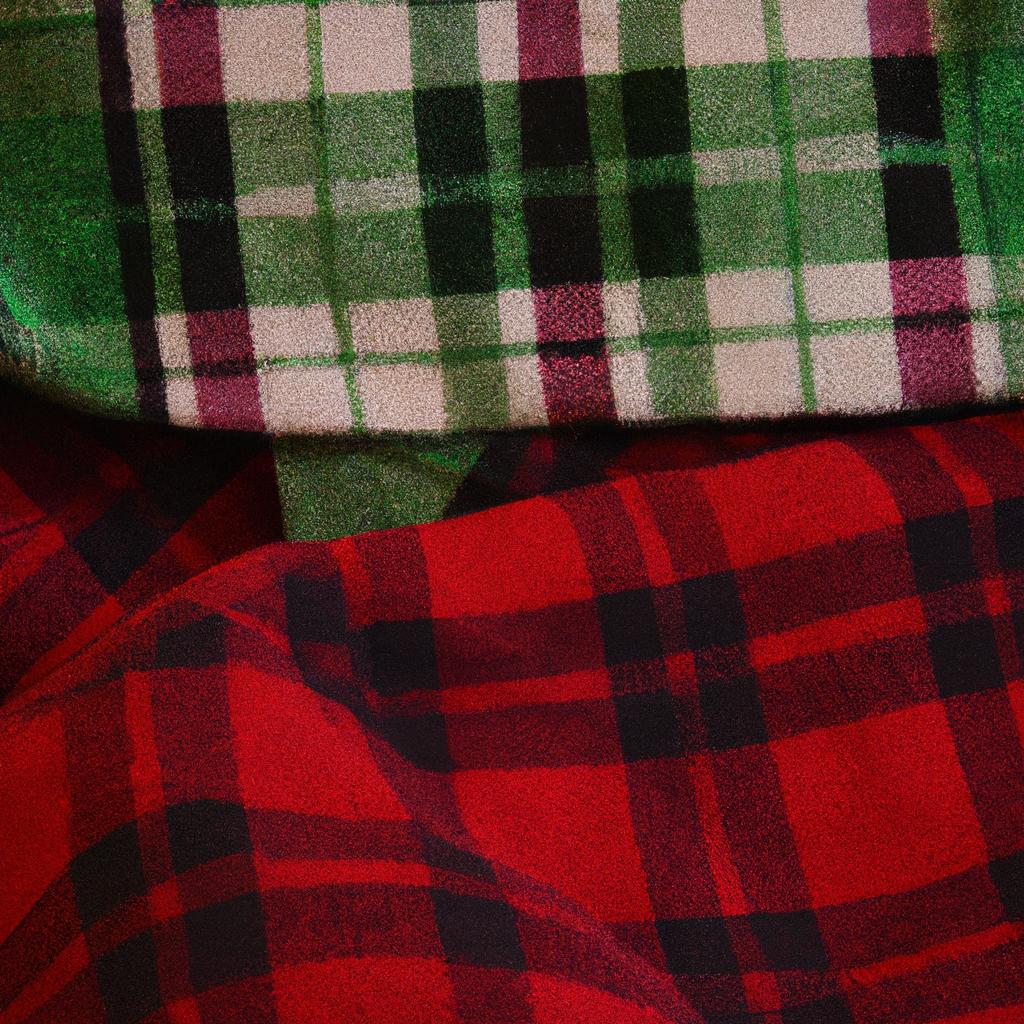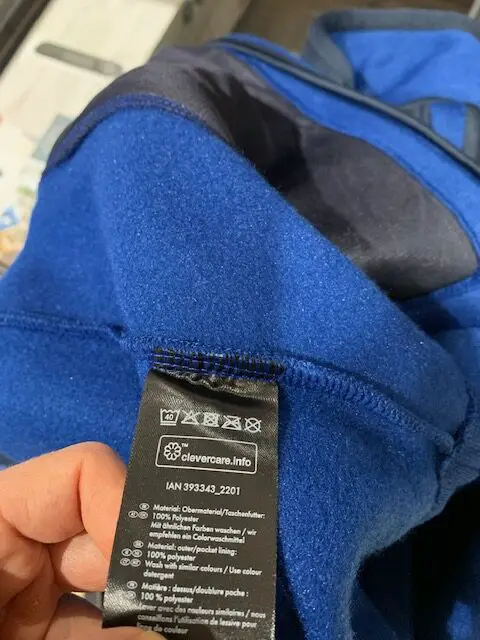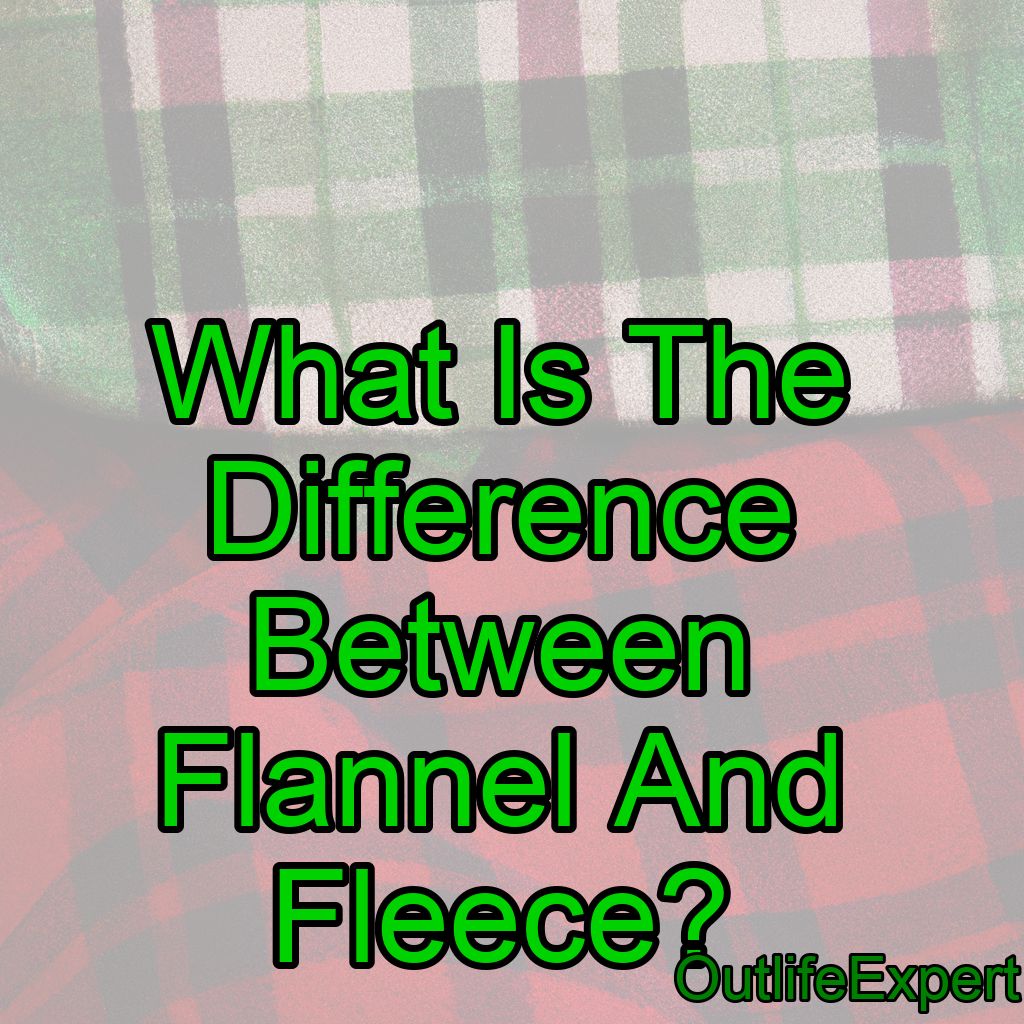Are you looking for the perfect layer to keep you warm and cozy in chilly weather? If so, then you may be considering fleece or flannel.
The difference between flannel and fleece lies in their material composition, production process, and characteristic.
The difference between flannel and fleece lies in their material composition, production process, and characteristics:
1. Material Composition: Flannel is typically made from natural fibers like cotton or a blend of cotton and synthetic fibers, while fleece is made from synthetic fibers, primarily polyester.
2. Production Process: Flannel is a woven fabric, created by weaving fibers together in a tight pattern, whereas fleece is a knitted fabric, produced by knitting fibers together in a looped pattern.
3. Characteristics:
– Flannel is soft, warm, and breathable, making it ideal for clothing and bedding. It has a slightly fuzzy surface due to the brushing process it undergoes.
– Fleece is lightweight, warm, and moisture-wicking, making it suitable for activewear and outdoor clothing. It has a plush, fuzzy texture on both sides.
In summary, flannel is a woven fabric made from natural or blended fibers, while fleece is a knitted fabric made from synthetic fibers. Flannel is known for its softness and breathability, while fleece is valued for its lightweight warmth and moisture-wicking properties.
Both fabrics are excellent choices for staying comfortable during outdoor activities, but there are some important distinctions between them that can help you make the best decision.
Let’s take a look at what sets these two materials apart from one another!

As an outdoor expert, I understand how important it is to have clothing items that will protect against even the harshest elements.
That’s why I’m here to break down the differences between fleece and flannel so you can find something that will provide optimum comfort without sacrificing your desire for freedom when outdoors.
Definition Of Flannel And Fleece
Flannel and fleece are two fabrics that have been popularized in recent years for their ability to keep us warm while also looking stylish. Both flannel and fleece feature a cozy, soft texture due to the high thread count of each fabric, providing excellent comfort.
In terms of cost comparison, both fabrics tend to be relatively inexpensive. Flannel is usually more affordable than fleece because it’s made with lighter weight fibers, making it an ideal choice for those on a budget.
On the other hand, breathability and longevity make fleece an attractive option if you’re willing to pay slightly extra for these benefits.
Additionally, water resistance makes either fabric suitable for outdoor activities like camping or hiking. With this knowledge in mind, let’s explore the differences between them when it comes to the makeup of each fabric…
Differences In Fabric Makeup
When it comes to differences in fabric makeup, fiber content is an important factor. Flannel is usually made with cotton or synthetic fibers, while fleece is usually made from polyester, wool, or a blend of the two.
Weave structure is another consideration when comparing flannel and fleece. Flannel has a soft and smooth finish, while fleece has a thicker weave, which gives it a rougher more fluffy texture.
Durability is an important factor for outdoor fabrics. Flannel is a durable fabric that is resistant to wear and tear, while fleece can be more prone to snagging.
Comfort is always a priority when choosing fabrics. Flannel is a cozy fabric that will keep you warm and comfortable, while fleece is lightweight and breathable, making it a great choice for active wear.
Insulation ability is another important factor. Flannel is a great insulator, while fleece is more lightweight and breathable, making it a better choice for warmer climates.
Breathability is also an important factor. Flannel is not very breathable, while fleece is more breathable, making it a better choice for active wear.
Weight is another consideration when comparing fabrics. Flannel is a heavier fabric, while fleece is lightweight and easy to pack.
Cost is also an important factor when choosing fabrics. Flannel is usually more expensive than fleece, but the cost depends on the quality of the fabric.
Washability is also an important factor. Flannel is usually machine-washable, while fleece can be more delicate and needs to be hand-washed.

Texture is another consideration when comparing fabrics. Flannel has a soft and smooth finish, while fleece has a thicker weave, which gives it a rougher texture.
Color retention is another important factor. Flannel tends to hold color better than fleece, which can fade over time.
Color variations are also an important factor. Flannel is usually available in a wide range of colors, while fleece is usually limited to a few colors.
Shrinkage rate is another consideration when comparing fabrics. Flannel is usually more prone to shrinking, while fleece is less likely to shrink.
Stretchability is another important factor. Flannel is usually not very stretchable, while fleece is more stretchable, making it a great choice for active wear.
Finally, finish is an important factor. Flannel has a soft and smooth finish, while fleece has a thicker weave and a rougher texture.
Fiber Content
When it comes to your outdoor wardrobe, you need fabrics that provide breathability, cost effectiveness and durability.
Flannel is a lightweight fabric made from cotton or wool in a soft brushed finish while fleece is thicker and softer with its polyester construction making it more durable than flannel but not as breathable.
Fleece offers the best of both worlds when it comes to cost effectiveness and warmth, whereas flannel may be less expensive but won’t keep you quite as warm in colder temperatures.
So which one do you choose? It all depends on what level of comfort and protection you’re looking for – grab your favorite today!
Weave Structure
Once you’ve considered the fabric makeup and durability comparisons, another important factor to consider is weave structure.
The texture contrasts of flannel and fleece can be quite different depending on their weave structure.
Flannel typically has a plain or twill weave that provides more breathability than fleece’s thicker interlocked construction, which traps in heat but may also trap odors.
In terms of cost variations, it all depends on how much warmth and comfort you want – if you prefer something lightweight yet still durable then flannel will likely fit your needs better whereas if you’re looking for something warm without sacrificing too much ventilation then fleece might work best for you.
So get ready to enjoy whatever outdoor activity comes your way with confidence knowing you have chosen the right fabric!
Durability
When it comes to outdoor activities, durability is key. We want our clothing and fabrics to be able to withstand the elements without worrying if they’re going to fray or tear.
Flannel and fleece both have their own unique properties that make them great for outdoor wear; however there are some differences in their durability you should consider before making a purchase.
Fleece typically has waterproofing properties which will keep you warm and dry even in wet conditions whereas flannel does not offer this level of protection but could still provide breathability for those looking for something lightweight.
Additionally, when washing your fabric, check the label as fleece may need special care due to its synthetic material makeup while cotton flannels can usually just go into the machine like normal.
So whether you’re looking for extra water resistance or a more breathable option, these two fabrics can give you the perfect combination of comfort and stability!
Differences In Use
Making the transition from fabric makeup to usage, let’s take a look at how these two popular fabrics differ when it comes to their cold weather performance.
Both flannel and fleece are great options for winter layering but they provide different levels of warmth depending on your needs.
Here’s what makes them unique:
In addition to temperature control, each type of fabric has advantages related to stain resistance and layering options which we’ll explore further in our next section.
With all this information in mind, it’s time to examine the advantages and disadvantages of each type of fabric as we move forward.
Advantages And Disadvantages Of Each Type Of Fabric
When it comes to outdoor fabrics, flannel and fleece are two of the most popular choices. And while they have a lot in common – they both keep you comfortable, warm and cozy – there’s one major difference between them: cost comparison.
Fleece is generally more expensive than flannel due to its superior breathability and washability. Flannel provides excellent insulation for cold weather hikes or camping trips, but when compared to fleece, it’s not as durable.
Both materials can be machine-washed with care; however, if you want your fabric to last longer, handwashing may be necessary for items made from flannel. When considering durability over time, fleece wins out since it has proven itself to stand up better against wear and tear than flannel does.
When making a decision about which material is best for your needs, consider the cost comparison along with other factors such as breathability comparison, washability comparison, insulation comparison and durability comparison. Understanding how each type of fabric performs will help you choose what works best for your situation – whether that’s an afternoon hike or a multi-day expedition.
Frequently Asked Questions
Is Flannel Or Fleece Warmer?
When it comes to the cozy feel and wearability differences, there is no denying that flannel and fleece are two of the most popular fabric types.
They both provide great warmth levels for any outdoor enthusiast looking to stay warm in colder climates.
However, when it comes to comfort levels, there is a noticeable distinction between these fabrics.
Flannel provides a softer texture while fleece has more of a brushed texture which makes it more durable and able to withstand harsher temperatures.
Wearing either one will ensure you stay comfortable on your next adventure!
How Much Does Flannel Or Fleece Typically Cost?
When it comes to choosing between flannel and fleece, money is no object!
For the savvy outdoorsman looking for uncompromising comfort and style alongside affordability, this epic comparison of both materials will leave you in awe.
Durability wise, they are similarly matched but each offers unique benefits when considering sustainability or color selection.
Assess your needs against their respective price tags for a match made in heaven – both offer unbeatable value for money.
With such an incredible array of options on offer, anyone seeking maximum comfort with a sense of freedom need look no further than these two fabrics.
How Easy Is It To Clean Flannel Or Fleece?
Cleaning flannel and fleece fabrics is an important factor to consider when looking for the best fabric type for your needs.
Flannel and fleece both have their own unique benefits in terms of wearability, durability, and texture comparison that can make them ideal choices for a variety of outdoor activities.
However, how easy they are to clean should also be taken into account.
Generally speaking, flannel is slightly easier to care for than fleece as it does not require special detergents or wash cycles; however, some manufacturers do recommend specific cleaning instructions based on the fabrics used in their products.
Fleece usually requires more specialized care with cold water washes and gentle detergent to preserve its softness and form over time.
Ultimately, understanding the ins-and-outs of each fabric’s care instructions will help you decide which one works best for you!
Are There Any Ethical Or Environmental Considerations When Choosing Between Flannel And Fleece?
When deciding between flannel and fleece, outdoor experts consider more than just comfort.
Eco-friendly production, sustainable fabrics, ethical labor practices, animal friendly materials, and synthetic fibers are all important factors to look out for in order to make an informed decision that reflects your values while providing the freedom of movement you need.
Whether you’re looking for a cozy layer or something lightweight enough for long hikes in unpredictable weather conditions, there are plenty of options available that don’t compromise on ethics or the environment.
Is Flannel Or Fleece More Breathable?
When it comes to breathability, flannel and fleece offer two distinctly different experiences.
Flannel is a lightweight fabric that provides excellent air circulation for those seeking relief from the heat of summer.
On the other hand, fleece is more densely woven and offers superior water resistance, making it ideal for colder temperatures.
Consider your climate when choosing between these two popular fabric options – both require careful maintenance and come in varying styles for all occasions.
When selecting flannel or fleece for durability comparisons and long-term care, make sure you understand how each fabric will wear over time so you can enjoy its beauty season after season.
Conclusion
In conclusion, choosing between flannel and fleece can be difficult.
If you’re looking for something to keep you warm on a cold winter night, then flannel is the right choice. Its natural fibers trap heat and are more comfortable than fleece’s synthetic fabric.
On the other hand, if cost is your main concern, then fleece may be the way to go since it usually comes at a lower price point.
In terms of cleaning and maintenance, both fabrics require minimal effort with most stains coming out in one wash cycle.
Finally, when it comes down to environmental concerns or ethical considerations, neither material has any major advantages over the other – they’re both pretty much equal in this regard.
So whether you’re an outdoor enthusiast seeking warmth and comfort or just someone who wants an affordable option that won’t take up too much time to upkeep, either flannel or fleece will provide what you need.




